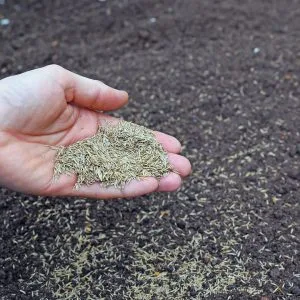Warmer weather is around the corner. Now is the time to start thinking about greening up your grass. After a long winter, many lawns show signs of wear and tear and damage from the elements. Here are some tips to help you prepare for and perform spring lawn seeding.
Types of Spring Lawn Seeding and Grass
Damaged lawns benefit from either spot seeding or overseeding. Spot seeding helps repair thinning or bare areas of the turf. Overseeding helps thicken already existing turf by planting seed throughout a previously established lawn.
Whether you are overseeding the lawn or just touching up bare spots, consider the type of seed you want to use. What grass seed type you use depends on where you live. Cool weather grasses like bentgrass, bluegrass, ryegrass, tall fescue, and fine fescue typically grow in regions where temperatures drop below freezing. If you are uncertain of what type of grass seed you’ll need, consult a professional.
Preparing for Spring Lawn Seeding
Before you seed, give grass a good cutting, setting the mower to go as low as possible. This makes it easier for the seed to make direct contact with the soil.
Give the mowed grass a good raking to remove clippings and get rid of debris and thatch. This also loosens the soil below. If necessary, aerate the lawn.
Fertilize the lawn prior to seeding to give new grass a healthy foundation in which to take root and grow. Use a starter fertilizer that contains nitrogen, phosphorus, and potassium to provide good nutrients for the seeds.
Planting Seeds
Your turf is ready for seeding. If you are spot seeding you can do it by hand. But if you are overseeding the entire lawn, you’ll want to use a spreader. There are handheld spreaders for smaller lawns and broadcast spreaders for larger ones. Follow the directions on the seed bag label when you adjust the settings on the spreader.
To prevent seeds from getting eaten by animals or getting washed away by heavy rains, you can cover them with a thin layer of straw until the seedlings are tall enough.
Caring for New Grass After Spring Lawn Seeding
It’s important to keep the soil moist after seeding. Water the area lightly once or twice a day until the new grass is about the same height as the existing lawn. Take into consideration spring rain and water less if there are rainy days. Wait until the new grass is three inches tall before the first mowing. And keep it free of foot traffic until the lawn is well established.
We Can Help
Many lawns suffer damage during the winter months. If your lawn looks like it needs more than a little tender loving care, call in an expert. Contact Free Spray Lawn Care at 419-529-5296 for more information on spring lawn seeding. We’ll get your grass healthy and looking lush for the warm weather months ahead.



Comments (0)
Thanks for your comment!
Thanks for your feedback! Your comments have been successfully submitted! Please note, all comments require admin approval prior to display.
Error submitting comment!
There is a problem with your comment, please see below and try again.